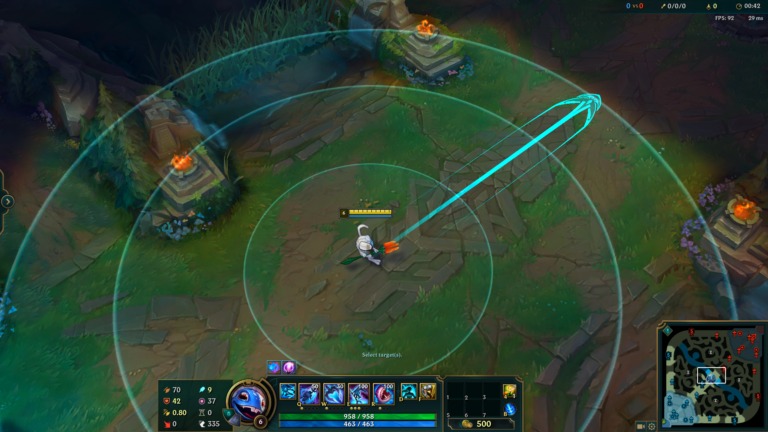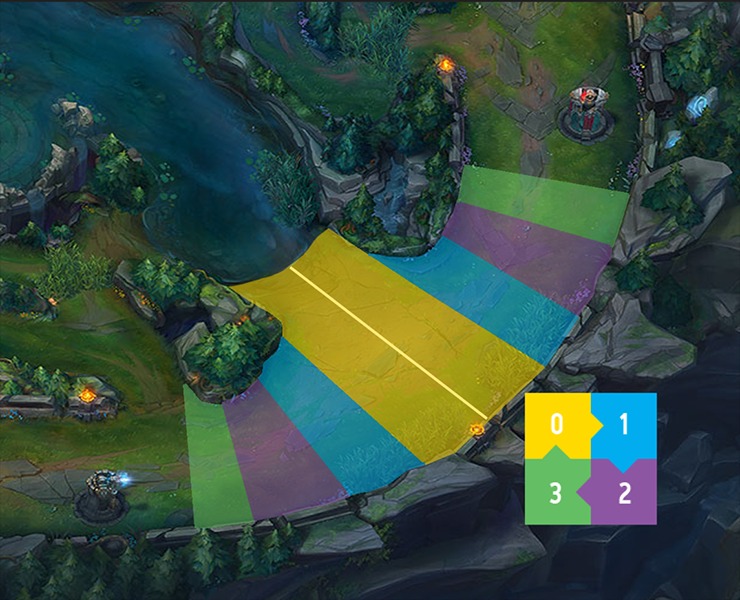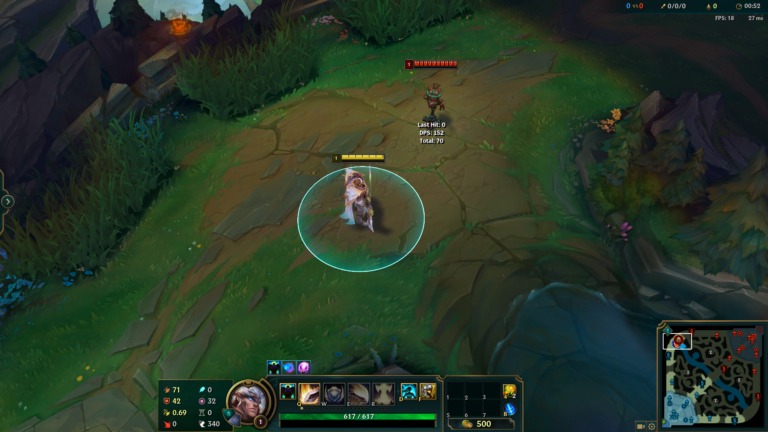When it comes to basic League of Legends gameplay, many players struggle with clear concepts and how to fully utilize them in an actual game. You’ve probably heard of the term zoning before- as it is thrown around the community quite frequently. But what actually is zoning and how and when do you do it?
In this Mobalytics guide, we are going to discuss how you can fully utilize zoning during the laning phase to gain a clear advantage over the enemy laner. Zoning in itself is very simple to understand, but knowing when you can do it and how you can prevent it is key.

Every champion has different zoning tools and ranges. If you have long ranged abilities, your zoning area of effect is much higher.
What is Zoning
Zoning in its simplest form is where you put yourself in a position that forces the enemy to play safer or more cautiously. If the enemy walks into your range or your zone, you can look to trade with them. Controlling the enemies movement and positioning in this way will all you to prevent the enemy from picking up minions as they will not be in range to get them. Or you’ll force them to farm with their abilities.
Zoning can allow you to gain a gold and experience advantage over the enemy laner as they will be missing out on last hitting minions as well as (potentially) being pushed out of the experience range. This will give you a noticeable advantage over the enemy that can definitely make a difference and delay the enemies power spike.
The example below is one of the earliest in League’s history, but still stands as a classic reference for learning this concept.
As suggested, zoning can also help you to trade with the enemy or gain a health advantage in lane depending on the matchup. For example, you can attack the enemy for free with your abilities while they’re overextended or trying to last hit. You can also threaten an all-in with champions such as a Leona or Blitzcrank who can use their main engage tool from afar.
During the laning phase, zoning can be a very powerful tool, and in the later stages it can be much stronger. In team fights, you can prevent the enemy from moving forward to get onto your carries or you can prevent the enemy from joining the fight.
Around objectives, zoning can force the enemy to back off and give it for free, or a zone can delay an enemies entry into the pit: which can provide enough time for your team to secure it.
How to Zone
Before you learn how to zone, you need to ask yourself if you can zone? Basically every champion can zone to some extent. Champions who have all in potential or who can start a skirmish are much easier to zone with. For example, Akali post level 6 is a very strong duelist thanks to her ultimate and her ability to all-in and skirmish greatly increases.

If your champion has crowd control or high amounts of damage and trading potential, then zoning can be pretty easy. The threat you hold to start a skirmish can force the squishiest of players to play back and play safe. On top of that, most players don’t really know the range of experience- so they’ll often stand outside of XP range which works heavily in your favor.
You always need to be somewhat stronger than the enemy in order to zone them. This doesn’t necessarily mean as a clear advantage such as levels, kills or items. It can be something very minute like a wave advantage, an ability or spell advantage (like a damaging Ultimate) or even your champions kit. For example, a bruiser like Renekton will have no trouble zoning off a tank in the early game.
Other factors that impact your ability to zone are as follows:
- Your Summoner Spells
- If you have an offensive Summoner, the enemy will have to play safer and respect your all-in potential. The extra damage Ignite can provide can make all the difference in a close combat situation. On the other hand, the enemy may want to look for an all in if they have their Ignite up.
- If you have Flash up, you can potentially engage. If you don’t have Flash, zoning can be more difficult as the enemy may try to fight you or request Jungler assistance. However, if you both are without Flash- this is less of a problem.
- The matchup you’re in
- If the enemy has the same dueling potential as you, it will be difficult to zone them as they may look to fight you for control of the wave. However, if you have are stronger than the enemy and have a clear advantage, then zoning is much easier.
- For example, if you’re playing as a bruiser against a tank or a mage vs a squishy champion.
- The enemies items
- What items the enemy has will have a slight impact on your ability to zone. This is due to the fact that they may be able to sustain the potential damage they may take by pushing up to farm.
- Alternatively, it may be because the enemy has an item that provides them with mana which allows them to farm with their abilities and from afar. Zoning in this situation is difficult because you may have to position further up to increase the distance that the enemy can farm from.
- The enemy Jungler
- If the enemy Jungler is someone who has shown keen interest in your lane, zoning can be quite difficult as they might show up and gank you while you’re positioning aggressively.
- If you die, you lose all future zoning potential because you will be put behind and potentially lose your Tower depending on the scenario.
- You can zone harder if you have good map awareness, good ward coverage and know where the enemy Jungler is at all times.
Now you know that you can zone, you need the call for action. There are 3 main zoning positions in the lane. The first is close to your Tower, the second is in the middle of the lane, and the third is under the enemies Tower: preventing them from getting close and approaching their objective.
The first and second zoning options are far more superior compared to the third. This is because the third zoning method is riskier and you have to be ahead in order to accomplish it.
You also have to be a much bigger threat to the enemy to force them away from the wave. We won’t really be talking as in-depth about it, but basically you have the wave pushed into the enemies Tower and walk up to the next minion wave and prevent the enemy from approaching their Tower.
As suggested, this is much riskier as you need to have good ward coverage inside the enemies jungle so you do not get caught out of position or ganked by roaming enemies. I would highly advise against doing this at all costs. But we had to include this as a zoning location regardless as it is possible in unique scenarios.
Zoning in the laning phase is much easier when the minion wave is even or closer to your side of the map. This is because the enemy has to over extend to farm and become increasingly vulnerable if they want to pick up CS. It also provides you with protection as the enemy has less opportunities and areas to gank from.
For the wave to remain in an area you want it, you first need to freeze it. To freeze it, you can just last hit the minion wave and let it push towards you. Then once all your minions are dead, you can tank the minion wave and run into the bushes when your wave arrives.

This will leave your minion wave with 3 less minions- meaning it will keep pushing towards you as long as you do not break the freeze or if the wave bounces. Once the minion wave is stationary there, you need to position yourself behind the enemy back minions. Standing here will force the enemy laner back and away from the wave.
If you want to zone in the middle of the lane, then you can clear the wave so there are no minions in the lane. This will force the lane to reset meaning both minion waves will meet in the middle. You then walk behind the enemy laners minions and position there.
Ideally, the minion wave will want to remain slightly closer to your side of the map after resetting. One way this can be achieved is by just last hitting and holding the wave there until your next minion wave comes.
In this example, Twitch pushed up while Sona was in a position to play aggressive and zone him away from the farm. This was rather successful and she was able to kill the Twitch because he didn’t take into consideration his health, lack of Support and Sona’s early game damage.
If you want to learn more about wave management, we have a seperate in depth article that covers this concept and more that can help you improve your wave management techniques so you can hold freezes and zone more.
Once you have got the minion wave in your ideal position, you need to put yourself in a position where you can be a threat to the enemy. Depending on the champion you’re playing, the area of effect can be longer. Someone like Xerath who has a long zoning area will not have to stand to far forward to zone compared to a Shen who is melee and has a short range.
If you are a short ranged zoning champion (like Shen, Darius, Renekton, Fiora) then you’ll need to move towards the backline of the enemies minions. You do not want to push too far up from here as you may miss out on minions as you might not be in a position to last hit them or reach them in time.

Garen auto attack range. Not much wiggle room. Note that his zone control will be slightly higher if his Q and Ultimate are up.
You stand here to bodyblock the enemy champion in lane from reaching the minion wave. If they walk too far forward, you can look for an all in. In the simplest of terms, you basically keep walking in and out of the minion wave to last hit and push the enemy off the wave.
If you are a long ranged champion (like Lux, Vel’koz, Xerath, Syndra) you can position yourself inside the enemy minion wave and look to poke the enemy down with abilities if they walk forward. You cannot always bodyblock the enemy champion like suggested for shorter ranged champions as it can be quite difficult. Traditionally, long ranged champions are also squishier so it is also much riskier to bodyblock the enemy champion.
When To Zone
Now you know who can zone and how to zone, you now need to know when to zone. If you zone when you shouldn’t be, it may work against you because the enemy may look for an all in while you’re isolated and over extended.
- When you have an advantage in lane
- There are many different advantages you can have in lane in order to zone. For example, a damaging Ultimate, strong dueling potential or a health advantage. If you have an advantage over the enemy, they have to respect you otherwise you’ll be able to trade with them.
- When the minion wave is closer to your side of the lane
- If the minion wave is pushed towards you, you can possibly look to zone the enemy depending on the matchup. For example, in the bottom lane if you have long ranged trading abilities such as Leona’s Zineth Blade, you can put yourself in front of the minion wave or inside of the bushes to stop the enemy duo from walking up
- If they walk up, Leona can quite easily engage with her E>Q or R>E>Q combo. Long ranged abilities engages are much more effective when the enemy has shorter range than yourself.
- If you’re in a good matchup
- Some champions are naturally better at zoning compared to others. Champions who are strong duelists like Fiora, Camille and Renekton are really good at zoning thanks to their bruiser/ duelist type gameplay.
- If you are stronger than the enemy in a 1v1, such as vs a Tank or against a squishy champion, then you can zone them away from the wave.
In this example clip, the act of zoning could have definitely been better. However, while the Akali was ahead, she was still rather squishy. She has to respect the Poppy’s passive shield and the empowered auto she gains from it. This increases her “zone”.
Once she had used it, Akali could position more aggressively and look to go in. This is a very common example and something that you will see in everyday gameplay. Unfortunately, it is quite difficult for you to zone the enemy completely away.
There are other scenarios that you can zone in. Many a time, the enemy will bless you by pushing the minion wave towards you. You can then use this opportunity to freeze the minion wave near your Tower and proceed to keep it there and zone them away from the wave.
How to Prevent a Zone
Preventing zoning is important to stay even in CS and not fall further behind. If you’re behind, try to keep the wave closer to your side of the map, preferably, near your Tower. This will reduce the enemies area of effect and allow you pick up farm without being zoned to much.
Wave management is crucial to prevent a zone because the number 1 way an enemy will zone you from farm is by having the wave on their side of the map. To prevent this, keep the wave always on your side of the map. This is the best way to prevent a low ranged small zoning champion. However, if the enemy has long range, then it will be slightly harder.
For long ranged zoners, you will need to dodge the enemies abilities by baiting the enemy to waste them. Once their abilities are down, their range decreases. Ideally, you can do this by walking into the zone, baiting out the ability, dodging it by walking backwards and then re-enter the zone once they are on cooldown.
This method is not foolproof though as you need to be able to dodge the enemy’s abilities. If you’re still struggling, ask for assistance to break the freeze or to kill the enemy laner will help you stop a zone and in some cases can prevent the enemy from looking to zone for the rest of the minion wave (depending on matchup).
Conclusion
To conclude, zoning is quite easy to understand as a whole but it is very situation dependent. Understanding the length of your zoning ability and the enemies is key for zoning to work. Walking too far forward will work against you, and standing too far back isn’t really zoning. It takes a lot of time to learn to zone effectively but practice definitely makes perfect like everything in League of Legends.